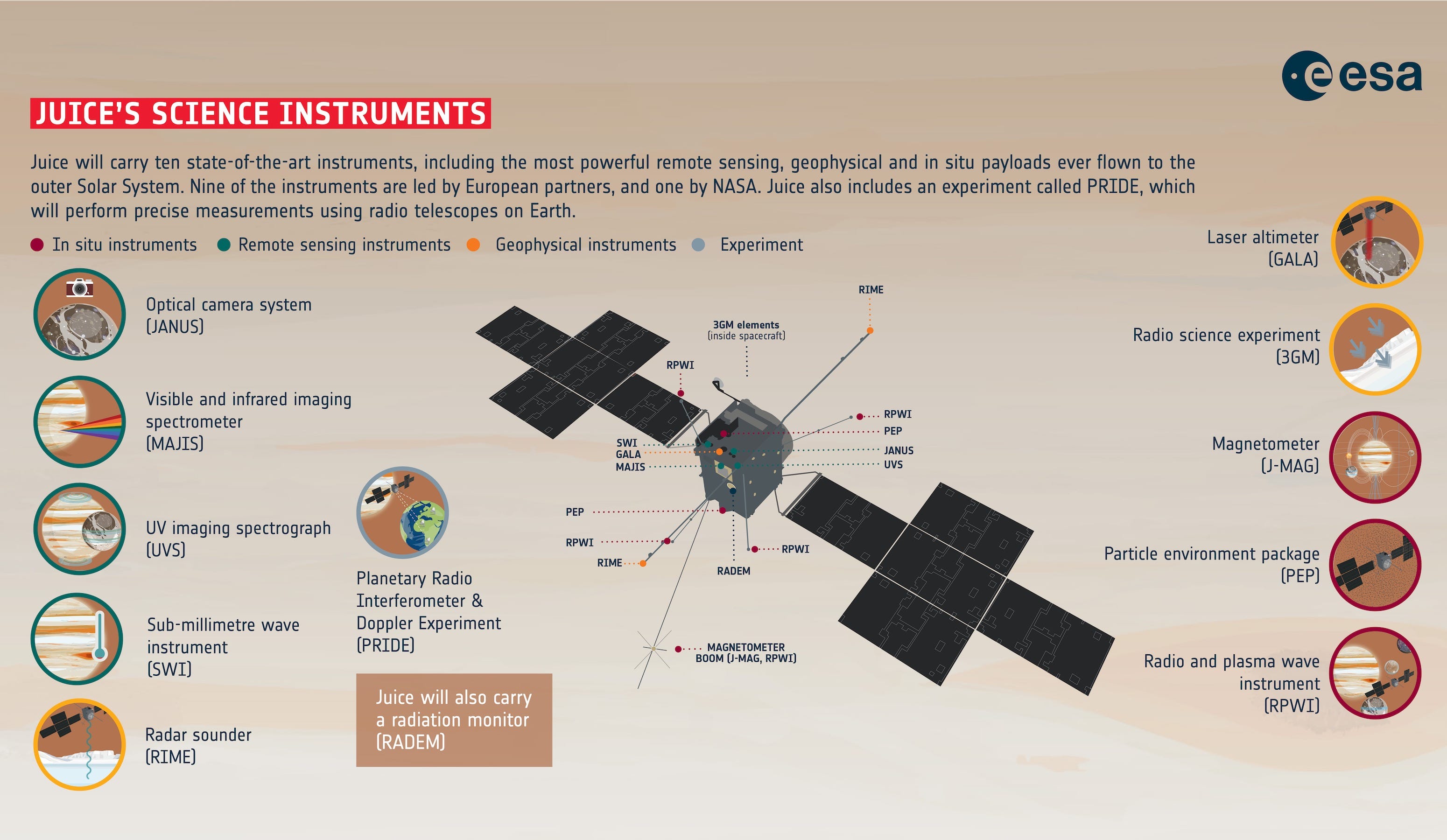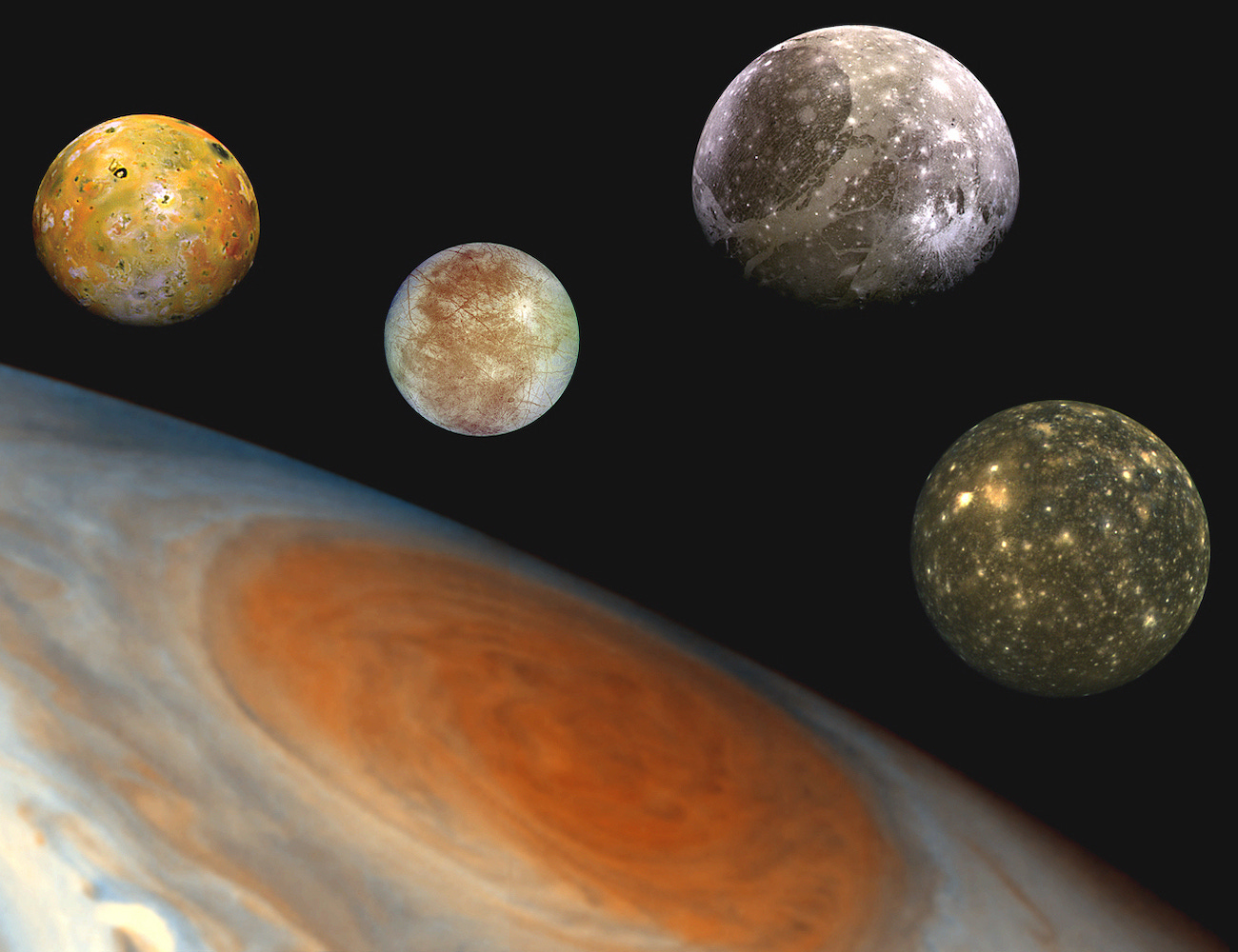Europe launches the JUICE spacecraft to explore Jupiter’s icy moons in unprecedented detail

Iconic missions to the outer Solar System such as Voyager 1 & 2, Galileo, and Cassini gave us a close look at the largest moons of giant planets. Once thought of as inactive, cold conglomerates of ice and rock, we now know these distant moons are planet-like worlds with rich histories. While our search for life in the universe was once restricted to Earth-like planets with terrestrial atmospheres and surface oceans, such icy moons with potentially habitable underground oceans offer new horizons.
Jupiter’s three largest icy moons—Europa, Ganymede and Callisto—all show hints of hosting liquid water oceans beneath their crusts. On Earth, life thrives in the deepest, darkest parts of our oceans near hydrothermal vents. Could life similarly evolve or survive in the underground oceans floors of these moons? The European Space Agency (ESA) successfully launched today, April 14, its boldest mission yet to find out.
The JUpiter ICy moons Explorer, or JUICE, will give us insights on how icy worlds around Jupiter and Jupiter-like exoplanets evolve. By finding out if Jupiter’s icy moons are habitable, JUICE will greatly expand possible places to look for life in the universe.
The journey

Over years now JUICE will perform a whole bunch of planetary gravity assists—orbital gymnastics, really—to arrive at Jupiter in July 2031. It will spend 3.5 years orbiting Jupiter, often flying within 200 to 1,000 kilometers of the icy moons. In this first phase of the mission, the solar-powered spacecraft will flyby Europa, Ganymede, and Callisto a total of 35 times, enabling repeated close studies of these icy moons in unprecedented detail. In the next and final mission phase, JUICE will orbit Ganymede starting December 2034 to study it closely for at least nine months. This would be the first time a spacecraft orbits a moon other than our own.
At 6,000 kilograms, JUICE is a heavy spacecraft. JUICE’s complex mission trajectories require it to carry more than 3,000 kilograms of fuel. JUICE hosts 10 state-of-the-art instruments, which together weigh only 104 kilograms thanks to experience gained by ESA in past missions. Japan has substantially contributed to 6 of these instruments.
The science

JUICE’s visible-and-infrared spectrometer will detect what the surfaces of the Jovian icy moons are made of. It will help us identify and map minerals across Ganymede’s surface, understand the formation of complex landforms on Europa and Callisto, and find organic molecules—building blocks of life—on each of the moon’s surfaces as signs of their potential habitability. A laser-altimeter onboard will complement this data by mapping 3D shapes of features on the moons.
NASA’s Hubble space telescope has observed hints of water vapor in Ganymede’s exosphere and water plumes erupting on Europa. JUICE’s ultraviolet spectrometer and charged particle detector can confirm such activity by identifying water molecules in the exospheres of these moons.
JUICE will also sport a novel sub-millimeter wave spectrometer, which detects light frequencies between infrared and microwave, to complement surface mapping and exospheric data from the aforementioned two spectrometers.
Part of the JUICE mission involves studying Jupiter too, since the giant planet considerably affects the icy moons and their conditions. Jupiter has a massive magnetic field, one that is 20 times stronger than Earth’s. And so Europa and Ganymede in particular, being fairly close to Jupiter, are showered in intense charged radiation particles traveling along Jupiter’s magnetic field lines. To that end, JUICE’s magnetometer, particle detector, and plasma instrument will together map and measure Jupiter’s magnetic field, radiation within, and how they alter material on the surfaces of the icy moons.
An ocean inside Ganymede
Ganymede is the only moon in our Solar System with its own magnetic field. JUICE’s magnetometer will measure it, explore how Jupiter’s field interacts with it, and study how charged particles raining down along the Jovian field lines cause the glowing aurorae on Ganymede.
Hubble’s aurorae observations of Ganymede, coupled with magnetic field measurements by NASA’s Galileo spacecraft, strongly suggest the presence of a 100 kilometers thick ocean—10 times deeper than Earth’s—on the moon, buried under 150 kilometers of ice. Such an ocean should affect magnetic field lines passing through it. JUICE’s magnetometer can sense such changes and could confirm the presence of this vast purported ocean. Similarly, JUICE will help solidify or nullify previous hints of an ocean inside Callisto.

Keep piercing
The Italian Space Agency and NASA are providing JUICE’s radar that can penetrate the surfaces of the icy moons as deep as 9 kilometers, showing us their internal structures for the first time. While the oceans of all three worlds are expected to lie further below, this data will inform us greatly on the nature of the icy terrain leading to them. This includes knowing about ice-sandwiched liquid water pockets (especially on Europa), how the crusts of the moons evolved over time, and how they shaped the surfaces to what they are today.
JUICE will also measure the gravity fields of Jupiter’s icy moons. As JUICE passes over denser and rarer regions of the moons, its position and velocity will be impacted by the changes in gravity. Two radio instruments onboard will note these finer movements of the spacecraft, allowing scientists to infer the gravity fields of the moons and thus provide insights into their interiors.
Jovian space odyssey
JUICE is part of ESA’s Cosmic Vision 2015-2025 program, which undertakes ambitious space science missions that take over a decade to realize. In May 2012, ESA selected JUICE as the program’s first of the three large-class missions, the other two being Athena and LISA. ESA completed a detailed study of JUICE’s design and goals in 2014, and then set out to build the complex Jovian explorer.
NASA is planning to launch Europa Clipper in late 2024, which will arrive at Jupiter in 2030. It will perform multiple flybys of Europa to help us better understand the moon’s ability to support life. China might send a mission to Jupiter's moons too, which could include a Callisto orbiter and lander. Together, these missions will inform us not only about the habitability of the icy moons of Jupiter but that of icy worlds around giant planets across the Universe.
Originally published at The Planetary Society in 2021, revised for 2023 per final launch and mission details.
→ Browse the Blog | About | Donate ♡
